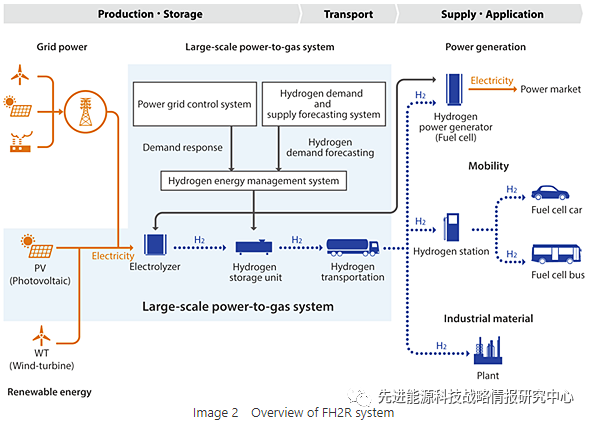Time:2020-04-30 Reading:10215

The New Energy and Industrial Technology Development
Organization (NEDO) of Japan recently announced the successful completion of
the world's largest renewable energy electrolysis hydrogen production
demonstration plant (FH2R) in Fukushima, with a capacity of 10 MW. The
demonstration plant, consisting of a 20 MW photovoltaic power station and a 10
MW electrolysis hydrogen production system, can produce up to 1200 Nm3 of
hydrogen per hour at its rated power. The pilot plant will explore how to
balance the power system's supply and demand by adjusting the amount of
hydrogen produced and maximize the utilization of fluctuating renewable energy
without using batteries. It aims to establish clean, low-cost hydrogen
production technology, specifically, the optimal operation control techniques
that combine the demand response of the power system and hydrogen supply-demand
with devices having different operational cycles. The produced hydrogen will
primarily be transported using compressed hydrogen trailers and portable
ultra-cold containers, supplied to customers in areas like Fukushima Prefecture
and Tokyo. It will be used for power generation in stationary fuel cells, as
well as in fuel cell vehicles and buses.
Editor's Note: The Japanese government issued the
"Basic Hydrogen Strategy" in December 2017, pointing out that with
the increase in the introduction and output of renewable energy, producing
hydrogen using renewable energy electricity (Power-to-Gas) is a key means for
surplus energy storage. Therefore, for hydrogen energy storage and utilization,
the goal is not only to maximize the use of renewable energy by leveraging the
power system's supply-demand balancing regulation function (demand response)
but also to optimize the system's operation based on the forecast of hydrogen
supply and demand. To explore the optimal combination of hydrogen
production/storage and power supply-demand balance adjustment, Japan's NEDO, in
collaboration with Toshiba Energy Systems & Solutions Corporation, Tohoku
Electric Power Co., Inc., and Iwatani Corporation, started the construction of
the world's largest renewable energy hydrogen production demonstration plant
(FH2R) in Namie, Fukushima Prefecture in 2018. Toshiba oversaw the entire
project and the overall hydrogen energy management system. Tohoku Electric
Power Co., Inc. was responsible for the grid energy management system (EMS) and
data collection and supervisory control and data acquisition (SCADA) related
matters. Iwatani Corporation handled hydrogen demand, supply forecasting system
setup, as well as transportation and storage of hydrogen.
The entire text is sourced from the "Advanced Energy
Technology Strategic Intelligence Research Center".